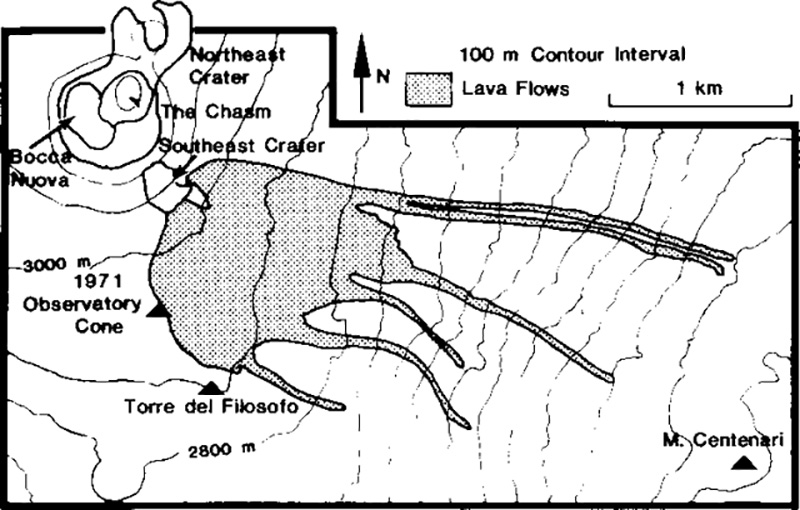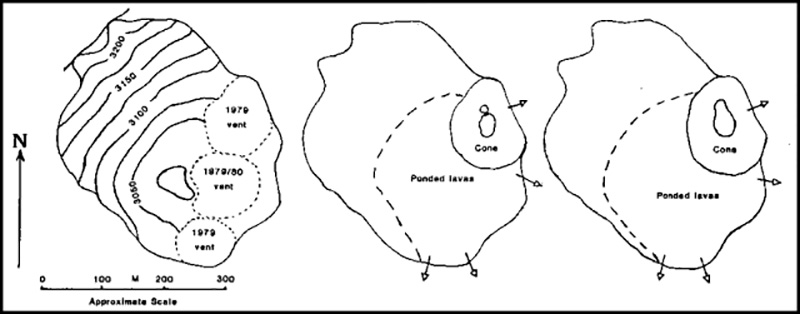Report on Etna (Italy) — September 1984
Scientific Event Alert Network Bulletin, vol. 9, no. 9 (September 1984)
Managing Editor: Lindsay McClelland.
Etna (Italy) Lava flows, Strombolian activity and ash emission
Please cite this report as:
Global Volcanism Program, 1984. Report on Etna (Italy) (McClelland, L., ed.). Scientific Event Alert Network Bulletin, 9:9. Smithsonian Institution. https://doi.org/10.5479/si.GVP.SEAN198409-211060
Etna
Italy
37.748°N, 14.999°E; summit elev. 3357 m
All times are local (unless otherwise noted)
Continuing strombolian activity, particularly intense at times (on the 14th and 20th) and very irregular in intensity and duration, marked the activity in September. Beginning 27 September, this activity was nearly replaced by expulsions of reddish ash at irregular intervals, rarely accompanied by the ejection of incandescent material (bombs and incandescent lava fragments). Lava flows, rarely thick (20 September), usually emerged from effusive vents on the S rim of the Southeast Crater at 3,050 m elevation, and were directed mainly SE, E, S, and ENE. A lava flow advanced S to about 100 m from the rifugio Torre del Filosofo. The flows moved across the lava field, rarely advancing below 2,700 m elevation, within the Valle del Bove.
"Strombolian activity occurred at the bottom of Bocca Nuova. The activity was particularly violent at times with ejection of incandescent lava fragments above the level of the crater rim (24 and 27 September). Generally, only gas emissions were observed. The Chasm usually remained obstructed. Rarely (11 and 24 September), incandescent gas under pressure was observed emerging from a small vent. From the Northeast Crater, isolated expulsions of reddish ash continued, but activity was usually limited to quiet gas and vapor emissions."
Michael Matson reported that a weather satellite image on 14 September at 0740 showed a plume at 4.5 km elevation or higher extending SE from Etna. Ejection of the plume was estimated to have begun 1-2 hours earlier. No plume was evident on an image at 0946.
The following report by Christopher Kilburn, is based on observations 25 August-1 October.
"Since the eruption began in late April, a cone has developed inside the upper E rim of the Southeast Crater, roughly coincident with the position of the most northerly vent active in 1979 (figure 15). On 1 October the cone was ~120 x 100 m at its base (the longer axis oriented roughly NNW) and some 30-40 m high. Until 20 September, the strombolian activity consisted of intermittent violent explosions, with peak frequencies of 14/minute and bomb trajectories ranging from subvertical to directed. Lower-angle ejections were mainly to the E and S, but occasionally to the N and W. Bombs of the order of 0.04 m3 had maximum ranges of ~300-400 m. After 20 September, the violence of the explosions markedly decreased. Weak ejections every few minutes or hours were interspersed with periods of inferred internal collapse that generated small convection columns of pale brown ash and dust. This change in explosive behaviour followed a brief period of rapid lava discharge to the E on 20 September as well as a period of heavy precipitation. Enlargement of the vent at the top of the new cone, which occurred sometime between 13 and 24 September, may have been associated with the 20 September lava discharge.
"Lava discharge was virtually continuous from ephemeral vents S and E of the base of the new cone. Lava flowed S, SE, and E over low points in the Southeast Crater rim. Activity typically alternated between the S and E vents at intervals of one to several days. The successive aa flows, few of which were longer than 1.5 km with frontal thicknesses rarely exceeding 5 m, created a compound flow field with an estimated area that approached 1.5 km2 by 1 October (figure 16). By 23 September, ponding inside the Southeast Crater had reached a maximum accumulated thickness of more than 45 m, raising the level of its bottom to ~3,065 m above sea level. Assuming a conservative average thickness of 5 m, and including the material within the Southeast Crater, a provisional estimate of the minimum volume of the flow field on 1 October is 8.5 x 106 m3, yielding a minimum average effusion rate of ~0.64 m3/s. Estimates of the eruption rate, made near the vent 17-28 September, were 0.5-1.0 m3/s for lava discharged toward the S. The chief uncertainties in these discharge rates are the velocity profiles across the flow surface and with depth, and the thickness of the flow; for the minimum value, parabolic velocity profiles and a flow depth of 3-4 m have been assumed, the maximum (central) surface velocity and lava channel width being estimated in the field.
 |
Figure 16. Provisional sketch map of 1984 lava flows as of 1 October. Courtesy of Christopher Kilburn. |
"The Strombolian activity at Bocca Nuova was accompanied by the emission of large quantities of SO2-rich fumes. Until at least 24 September, magma was probably roughly 100-200 m below the W rim; observations were obscured by fumes. An apparently fresh bomb was found ~20-30 m from the NW rim 24 September, while others, up to 70 cm across, were seen being expelled toward the N and NW 28-29 September to a maximum estimated range of ~100-120 m. It is not known whether ejection of material outside the crater indicated a rise in level of magma within Bocca Nuova or an increase in explosive vigour due to changes in the physical state of the magma, notably in its vesicle content."
Geological Summary. Mount Etna, towering above Catania on the island of Sicily, has one of the world's longest documented records of volcanism, dating back to 1500 BCE. Historical lava flows of basaltic composition cover much of the surface of this massive volcano, whose edifice is the highest and most voluminous in Italy. The Mongibello stratovolcano, truncated by several small calderas, was constructed during the late Pleistocene and Holocene over an older shield volcano. The most prominent morphological feature of Etna is the Valle del Bove, a 5 x 10 km caldera open to the east. Two styles of eruptive activity typically occur, sometimes simultaneously. Persistent explosive eruptions, sometimes with minor lava emissions, take place from one or more summit craters. Flank vents, typically with higher effusion rates, are less frequently active and originate from fissures that open progressively downward from near the summit (usually accompanied by Strombolian eruptions at the upper end). Cinder cones are commonly constructed over the vents of lower-flank lava flows. Lava flows extend to the foot of the volcano on all sides and have reached the sea over a broad area on the SE flank.
Information Contacts: R. Romano, IIV; C. Kilburn, Univ. of London; J. Murray, D. Decobecq, and C. Delmotte, Univ. Paris Sud; P. Briole, PIRPSEV; M. Matson, NOAA.


